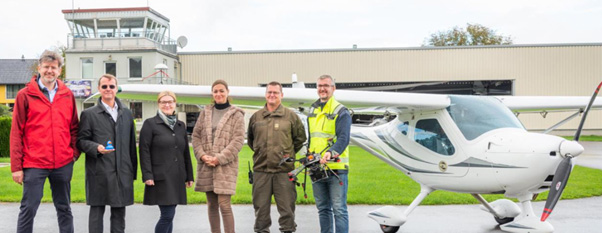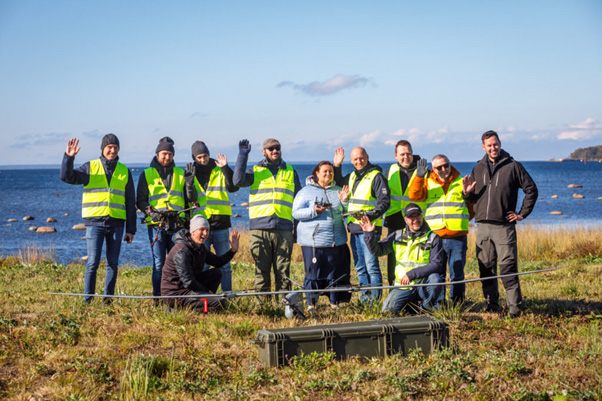The SESAR GOF 2.0 very large-scale demonstration is developing solutions for the safe and sustainable integration of unmanned aerial vehicles and air taxi operations in urban airspace. In September, a series of tests took place in Austria and Estonia, the findings of which marked another important milestone in the development of U-space.
Fifteen partners from both the scientific community and the drone and aviation industry have been working together in the project GOF 2.0 to enable safe, orderly, and efficient control of unmanned aerial systems in a manned aviation environment. Interoperability is at the forefront, enabling secure (data) communication between airborne and ground-based systems. This creates a “system of systems” that combines classic air traffic management and new and improved drone-specific services.
The basis for an economical and scalable use of this new type of airborne mobility technology is the further integration of airport and port infrastructure, public transport, and logistics centres. In all use cases, the focus is on increasing efficiency compared to ground-based technologies and supporting a seamless transport chain between urban areas and the airports while taking into account the highest safety requirements.
St. Georgen am Ybbsfeld Airport – not far from Amstetten / Lower Austria – was chosen for the Austrian validation. In this trial, among other things, automated parcel delivery at low-altitude and its safe interaction with air taxi flights and conventional air traffic were extensively tested as an example of a realistic use case.
“It is of utmost importance that we can integrate drone traffic control systems directly into our air traffic management systems and ensure a safe and smooth operation,” explains Günter Graf, Vice President New Business Development and Innovation at Frequentis, the Austrian GOF 2.0 partner and host of this validation. “Many thanks to our partners for the good cooperation and their attendance with us in Austria. The team is working excellently, and the results are promising.”
“GOF2 demonstrations highlight the importance of integrating U–space information directly into drone operator mission control systems“, says Jonas Stjernberg, SVP and Partner at Robots.Expert, and continues, “the biggest challenge for the industry and regulators is to ensure that U–space systems are interoperable on a European level.

Meanwhile, in Estonia, trial flights took place in Viimsi to test systems and technical solutions developed for the management of unmanned air traffic in urban environments and for supporting drone flight in controlled and uncontrolled airspace.
According to Tanel Järvet, CEO of Estonian drone and robotics company CAFA Tech, almost all commercial flights performed by drones are already automated. But we need common control systems to ensure the safety of everyone using the airspace.
“We have been testing different systems for unmanned aviation since 2019, and have now integrated the C2 control systems of CAFA Tech drones with the unmanned aviation system. As a result of our work, the positions of our drones can be monitored in real time by all aircrafts in a single air traffic control system,” said Tanel Järvet.
In addition to flexibility, the technical solutions developed allow unmanned aviation to be integrated with conventional aviation, and the positions of drones can also be shared in real time. For example, this means that if a medical helicopter and a package delivery drone want to reach the same building at the same time, the new system makes it possible to automatically postpone the delivery drone’s flight by something like 20 minutes until the medical helicopter has left the area.
According to Maria Tamm, Project Manager at EANS, U-space is needed to speed up the pre-flight approvals of unmanned flights and, in particular, to support flights that operate outside of the direct line of sight and share airspace with several other users, including manned aircrafts. “With U-space, we can integrate drone flights into the single airspace in such a way that these flights will take place in a safe and secure manner while also supporting the real needs of companies and operators. To this end, manned and unmanned aviation systems need to communicate with each other and exchange information necessary for aviation activities with all parties, thus enabling flexible airspace use,” said Tamm.

The GOF 2.0 consortium consists of: Estonian Air Navigation Services (EANS), Dimetor, Airbus Urban Mobility GmbH, Aviamaps, CAFA Tech, DroneRadar, EHang, Fintraffic ANS, Frequentis, PCSS Poznańskie Centrum Superkomputerowo-Sieciowe, Polish Air Navigation Services Agency, Robots.Expert, Threod Systems, Unmanned Life, Vaisala.
This project has received funding from the SESAR 3 Joint Undertaking under the European Union’s Horizon 2020 research and innovation programme under grant agreement No 101017689.
